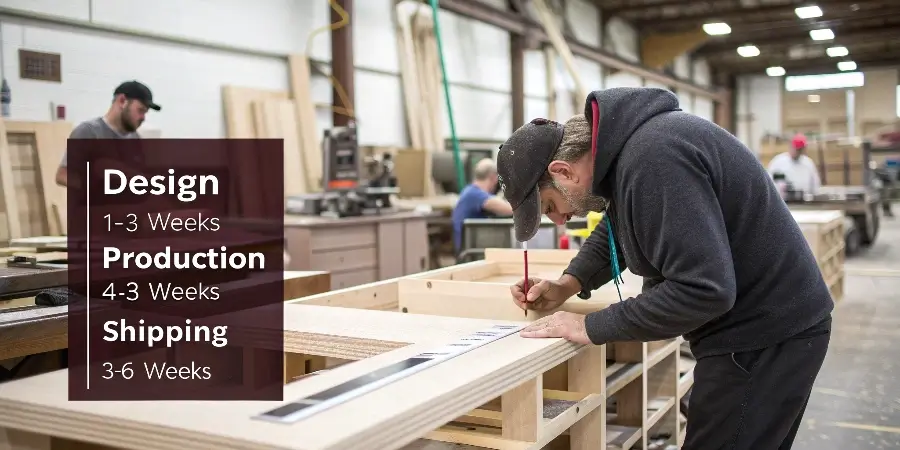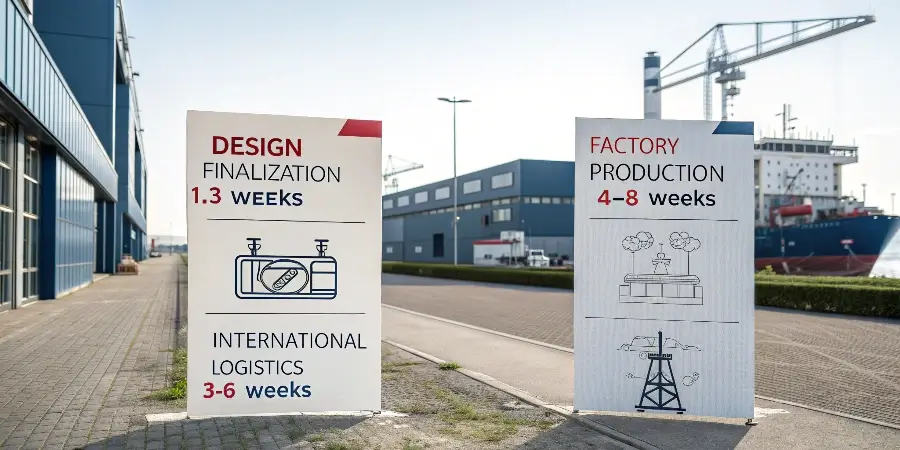How Long Does It Really Take to Get Furniture from China?
Project delays are a nightmare. You get vague shipping estimates from suppliers, leaving you unable to plan your timeline and budget accurately, which puts your entire project at risk.
For custom furniture, the total time from order to delivery is typically 8-14 weeks. This includes 1-3 weeks for design, 4-8 weeks for production, and 3-6 weeks for shipping. The timeline is much shorter for stock items, but it’s never just about shipping time.

As the CEO of Boke Furniture, I help international buyers manage their supply chains from Foshan. When a client asks about delivery time, I know they aren’t just asking about the boat ride. They need to know the entire project timeline, from the day they sign the order to the day the furniture arrives on-site. The common "4-6 weeks" answer you see online is misleading because it only covers ocean freight. It ignores the critical stages that happen before the container is even loaded. A professional buyer like you needs the full picture to manage a project successfully. Let’s break down the realistic timeline and the factors that influence it.
How long does it take for furniture to come from China?
You ask for a delivery date. You get a vague answer about "weeks" that doesn’t help you schedule installers or manage client expectations. You need a detailed breakdown to plan properly.
The total time is a sum of three distinct stages: design finalization (1-3 weeks), factory production (4-8 weeks), and international logistics (3-6 weeks). Understanding each stage is the only way to get a realistic delivery date.

The biggest mistake is to only focus on shipping. The total lead time1 is a chain of events, and a delay in one stage affects all the others. A realistic timeline helps you manage your project and avoid costly surprises. Here at Boke Furniture, we break it down for our clients so there is full transparency.
- Phase 1: Design & Order Preparation (1-3 weeks). For custom projects2, this is where we finalize shop drawings, materials, colors, and all order details. This phase depends heavily on your feedback speed. Quick decisions mean we can move to production faster.
- Phase 2: Production & Manufacturing (4-8 weeks). This is the longest phase. It includes sourcing raw materials, cutting, assembly, finishing, and quality control. The complexity of your furniture directly impacts this timeline. Simple office chairs are faster than a custom hotel lobby reception desk.
- Phase 3: Shipping & Logistics (3-6 weeks). This phase starts after production is finished. It includes export customs clearance in China, ocean freight, and import customs clearance and inland delivery in your country.
| Stage | Key Activities | Average Time | Key Factors Affecting Time |
|---|---|---|---|
| Design Prep | Drawings, material samples, order details | 1-3 Weeks | Client feedback speed, design complexity |
| Production | Material sourcing, manufacturing, QC | 4-8 Weeks | Product complexity, factory capacity, order size |
| Shipping | Sea freight, customs clearance | 3-6 Weeks | Port congestion, destination, shipping season |
Is it worth buying furniture from China?
You look at the long timeline and wonder if it’s a deal-breaker. The wait feels like a big risk for your project, making you question if the cost savings are worth the uncertainty.
Yes, for B2B buyers, it is absolutely worth it. The time invested gains you access to a complete supply chain. This offers unmatched cost-effectiveness, customization, and quality control—a strategic advantage, not just a purchase.
The delivery timeline might seem long, but it’s important to understand what you gain during that time. When you source from a manufacturing hub like Foshan3, you are tapping into an entire ecosystem. The 4-8 week production window isn’t just "waiting time." It’s when skilled craftspeople build your products to your exact specifications. Our access to a dense network of raw material and component suppliers here means we can often source materials faster than factories in other countries. This can actually shorten the overall production timeline compared to places that have to import all their components. For a commercial buyer like Jacky from Canada, the ability to get high-quality, customized furniture4 at a competitive price far outweighs the shipping time. The key is to plan for it. By factoring this timeline into your project schedule from the beginning, the wait becomes a predictable part of the process, not a source of stress.
How long is the average shipping from China?
You need a clear number for the shipping part of the timeline to plan your logistics. But "average" doesn’t account for your specific needs, like speed versus cost.
Ocean freight, the most common method, takes 3-6 weeks to North America or Europe, not including customs. Air freight is much faster at 5-12 days but costs significantly more. The best choice depends on your project’s budget and urgency.

The term "shipping" itself needs to be broken down. Over 90% of furniture is moved by ocean freight5 because it’s the most cost-effective solution for large, heavy items. When we say 3-6 weeks, that’s the time the vessel is on the water. It doesn’t include the 1-2 weeks it can take for trucking to the port, clearing customs in China, and waiting for the ship. At the destination, you also have to factor in port unloading and customs clearance. For my clients with tight deadlines, we sometimes use a hybrid strategy. We might air freight6 a few key pieces or samples to get the project started, while the bulk of the order follows by sea. This approach gives you flexibility. It is crucial to discuss these options with your supplier to find the right balance between speed and cost for your specific project.
| Shipping Method | Transit Time | Cost Level | Best Use Case |
|---|---|---|---|
| Ocean Freight | 3-6 Weeks | Low | Large, bulk orders where cost is a priority |
| Air Freight | 5-12 Days | High | Urgent samples or small, high-value orders |
How long does it take to get orders from China?
Your order is placed. You think the timeline is locked. But you know that unexpected delays can still happen, and you want to know what to watch out for.
Beyond production and shipping, delays often come from slow approvals, customs issues, or seasonal rushes like Chinese New Year. Proactive planning and clear communication with your supplier are the best ways to keep your order on schedule.

As a buyer, you can do several things to protect your timeline. The most common delays are often predictable and avoidable.
- Plan Around Peak Seasons. The two biggest periods to be aware of are Chinese New Year7 (usually late Jan/Feb) and the pre-Christmas rush (Oct-Dec). During Chinese New Year1, factories shut down for 2-3 weeks. In the holiday season, shipping lanes get congested and prices go up. A good supplier will help you plan production to avoid these bottlenecks.
- Prepare Customs Documents8 Early. Delays often happen at your country’s port, not in China. Make sure you and your supplier have all the necessary paperwork ready. This includes the Commercial Invoice, Packing List, Bill of Lading, and any required certifications. Clear communication here is key.
- Choose a Strong Supply Chain Partner. Working with an experienced supplier in Foshan makes a huge difference. We can anticipate potential issues, manage production schedules effectively, and navigate the complexities of international logistics because we do it every single day. A proactive partner is your best defense against unexpected delays.
Conclusion
Getting furniture from China is a manageable process. A realistic t
-
Understanding total lead time is crucial for effective project management and avoiding delays. ↩ ↩
-
Exploring best practices for custom projects can enhance your project management skills and ensure successful outcomes. ↩
-
Explore this link to understand how sourcing from Foshan can enhance your production efficiency and product quality. ↩
-
Discover resources that can help you locate top suppliers for customized furniture, ensuring you get the best for your needs. ↩
-
Understanding ocean freight is essential for cost-effective shipping solutions, especially for large items. ↩
-
Exploring air freight benefits can help you make informed decisions for urgent shipping needs. ↩
-
Understanding the effects of Chinese New Year on supply chains can help you plan better and avoid delays. ↩
-
Proper preparation of customs documents is crucial for smooth shipping; this resource will guide you through the process. ↩
